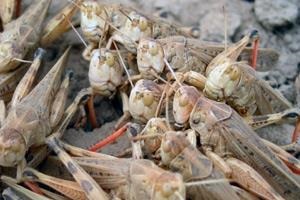
19 May 2011, Rome – FAO will assist ten countries in Central Asia and the Caucasus to save up to 25 million hectares of cultivated farmland from a locust crisis. Locusts are a serious threat for agriculture, food security and livelihoods in both regions including adjacent areas of northern Afghanistan and the southern Russian Federation.
A five-year programme to develop national capacities and launch regional cooperation is about to start thanks to assistance from the United States of America. Support from other donors is expected soon.
Ten countries at risk
In all, ten countries are at risk: Afghanistan, Armenia, Azerbaijan, Georgia, Kazakhstan, Kyrgyzstan, Russian Federation, Tajikistan, Turkmenistan and Uzbekistan. There are three locust pests in the region — Italian, Moroccan and Migratory locusts — which can attack all kinds of crops and plants.
“As borders are situated across the locust traditional habitats and breeding areas, when a country is facing locust infestations, it is more than likely that at least one neighboring country faces a similar situation,” said Annie Monard, FAO Locust Officer.
These migrant pests, able to fly up to 100 kilometres a day, are extremely opportunistic, adapting quickly to changing weather patterns, including those associated with climate change.
Central Asian and Caucasian countries made official requests to FAO for assistance in curbing locust outbreaks and related impact on food security and in developing transborder cooperation.
The FAO Locust Group initiated a process for assessing the needs and helping countries to improve national and regional locust management; a two-year project (2009-2011), funded through its Technical Cooperation Programme, contributed to this effort.
Together with the concerned countries, FAO then prepared a five-year programme for sustainable management of locust issues in Central Asia and the Caucasus. The programme is based on the key concepts of locust preventive control and is part of the locust component of the agency's EMPRES Programme.
The programme promotes preparedness, early warning and early reaction. It also seeks to introduce new techniques for locust control using less environmentally hazardous pesticides, including bio-pesticides.
A major contribution to this programme was recently received from USAID ($1.6 million) and negotiations are underway with other donors such as the Russian Federation, France and Turkey, which indicated their willingness to support the approach.